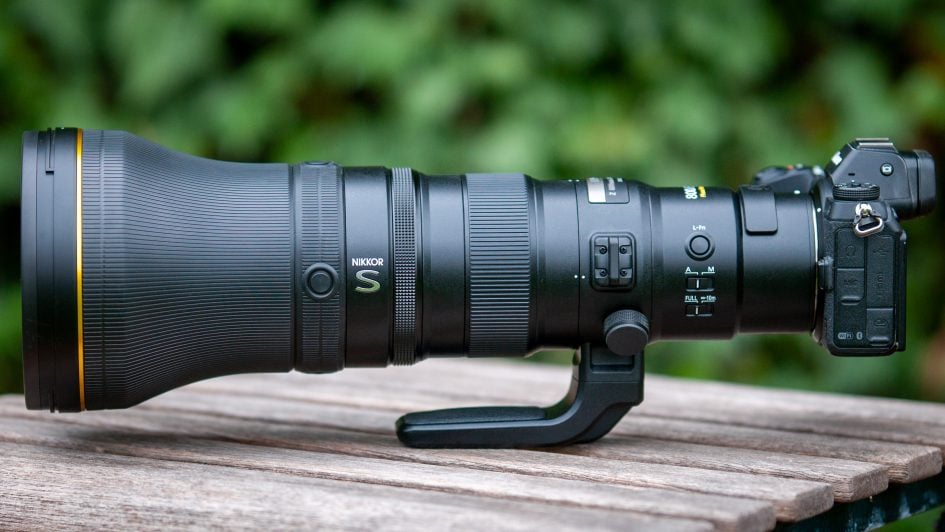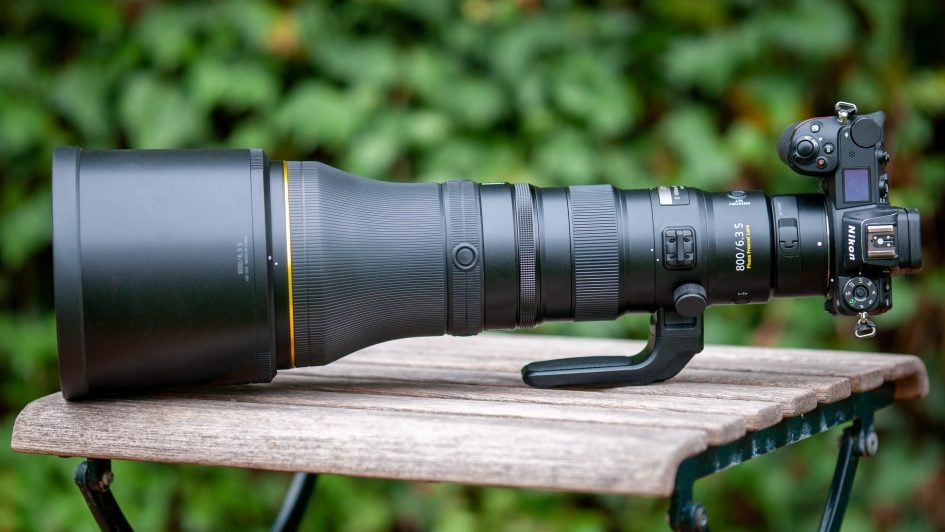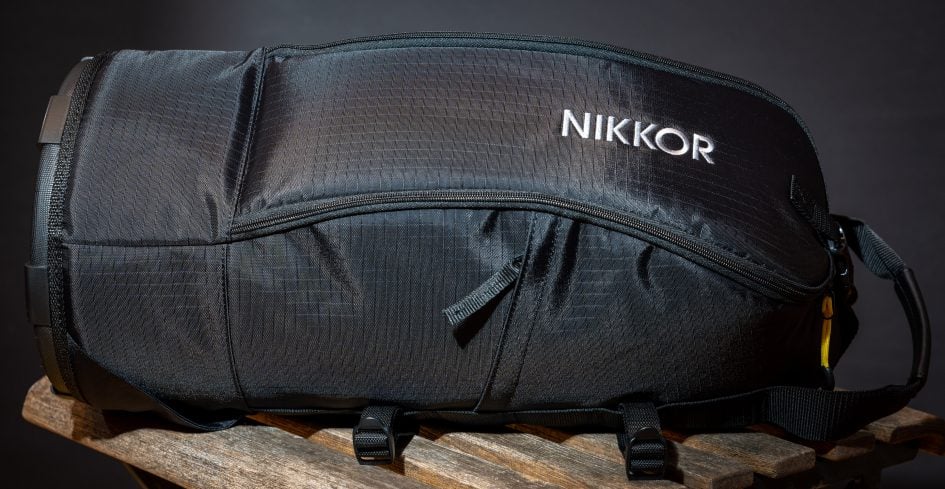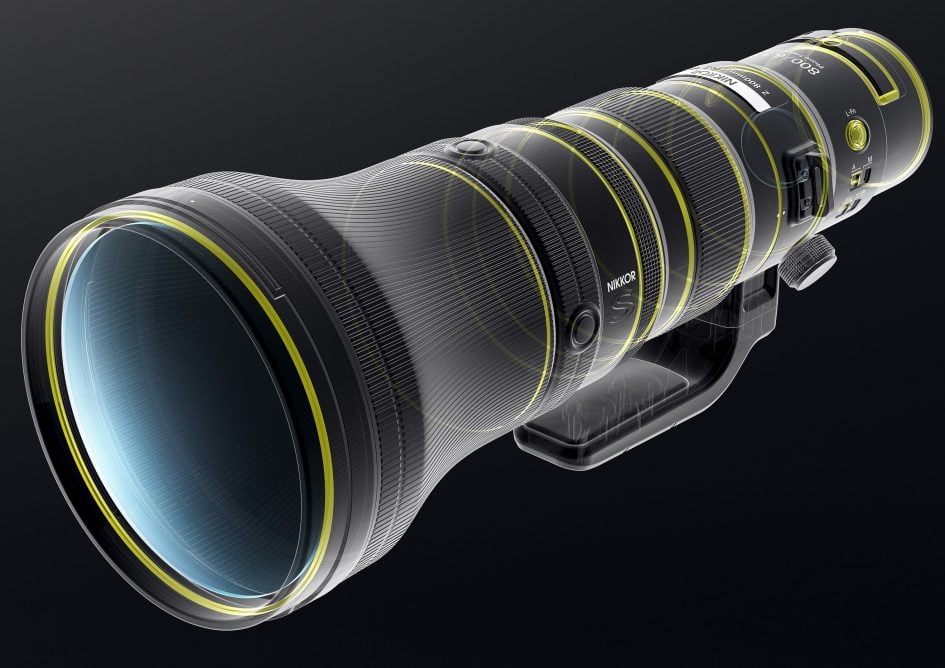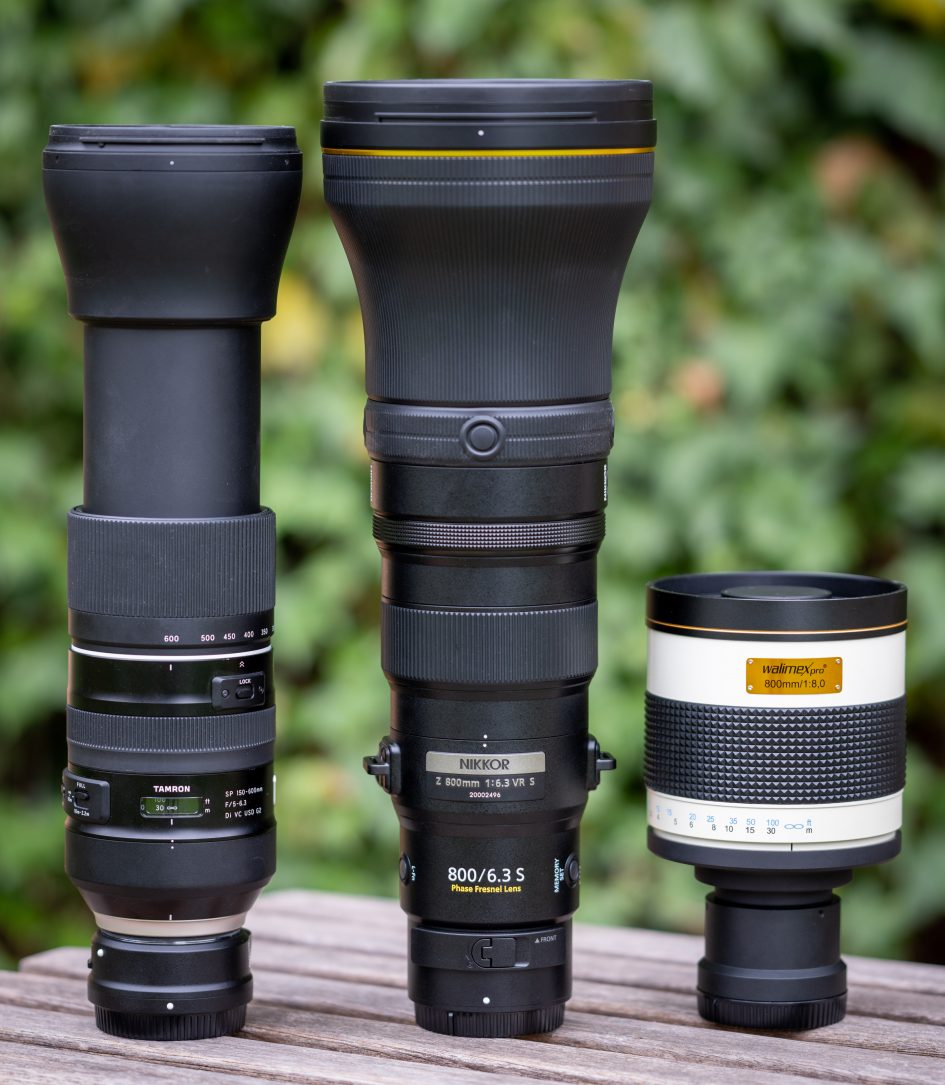Nikon Z 800mm f6.3 VR S review
-
-
Written by Thomas
Intro
The Z 800mm f6.3 VR S is Nikon’s longest telephoto prime lens for Z-mount so far. It has a large f6.3 focal ratio and is aimed at professional sports and wild-life photographers. Using a Phase-Fresnel element the lens is not longer than Nikon’s Z 400mm f2.8 TC VR S and much lighter at only 2.4kg which makes it substantially shorter and lighter than its F-mount predecessor, the Nikon AF-S 800mm f5.6E FL ED VR which was introduced in 2013 and still can be used via FTZ adapter on Nikon’s Z cameras.
The new lens is corrected for full-frame cameras and is compatible for use with Nikon’s Z-mount teleconverters TC-1.4x and TC-2.0x. This allows it to be converted into a 1120mm f9 or even 1600mm f13 lens. Used on a cropped body like the Z fc or Z50 (or in DX-mode on any full-frame Z camera) it delivers a field of view equivalent to 1200mm, 1680mm or even 2400mm focal length (depending on the use of TCs). Like the Z 400mm f2.8 TC VR S the new lens has optical image stabilization, a focus limiter, programmable function buttons, an extra memory-set button to save focus distances, an integrated filter slot to drop in standard 46mm filters, and the usual control ring. But the Z 800mm f6.3 VR S misses out on the additional function ring, the “meso amorphous” anti-reflex coating, and most importantly the integrated teleconverter of the Z 400/2.8. The focus ring can be switched from non-linear to linear response with a choice of different rotation angles (on a Z9 or Z6/7 II with firmware 1.4). And the OLED display which has been a hallmark of every high-end Z-Nikkor so far is missing.
The Nikon Z 800mm f6.3 VR S is made in China and costs 7299 EUR / 6497 USD / 6299 GBP. This is much less than its F-mount predecessor which is still 17k EUR or Canon’s brand new RF 800mm f5.6 L IS USM which is listed for 20k EUR.
And if you’re interested in other super-telephoto Z-Nikkors which can reach 800mm focal length with the help of a 1.4x or 2x teleconverter: There’s the Z 100-400mm f4.5-5.6 VR S and Z 400mm f2.8 TC VR S, plus Nikon’s lens roadmap for the years 2022 and 2023 shows a Z 200-600 VR, a Z 600mm f4 VR S, and a Z 400mm f4.5 VR S (focal ratios for the 600mm and 400mm lenses are guestimates).
Facts and features
Let’s compare the Nikon Z 800mm f6.3 VR S (“Z 800/6.3” for short) to the Nikon AF-S 800mm 5.6E FL ED VR (“F-Nikkor”), and their Z 400mm f2.8 TC VR S (“Z 400/2.8”) which can be converted with Nikon’s Z TC-2.0x into a 800mm f5.6 lens. I’ve also added some information on Canon’s RF 800mm f5.6 L IS USM (“Canon RF”) just to give you an idea where the competition stands. Sony does not (yet) offer an 800mm lens. As usual I’ve rated the features with a [+] (or [++]), when it’s better than average or even state of the art, a [0] if it’s standard or just average, and [-] if there’s a disadvantage.
Size (diameter x length): 140 x 385mm (5.5 x 15.2in.), the lens hood adding 126mm. The Z 400/2.8 + TC-2.0x is 156 x 413mm + 127mm lens hood. The F-Nikkor is 160 x 461 mm + lens hood. Add 30mm for the FTZ adapter to use it on a Nikon Z camera. The Canon RF 800mm f5.6 is 163 x 432mm. So Nikon’s new 800mm lens is relatively compact. [+]
Weight: 2382g (5.2 lb.) including tripod foot plus 241g for the lens hood. The Z 400/2.8 + TC-2.0x is 3201g including tripod foot + 232g lens hood. The F-Nikkor is 4590 g + lens hood. Add another 133g for the FTZ adapter to use it on a Nikon Z camera. The Canon RF is 3140g without lens hood. So Nikon’s new 800mm lens sets a benchmark of how light a 800mm f6.3 can be which is not a mirror lens construction. [++]
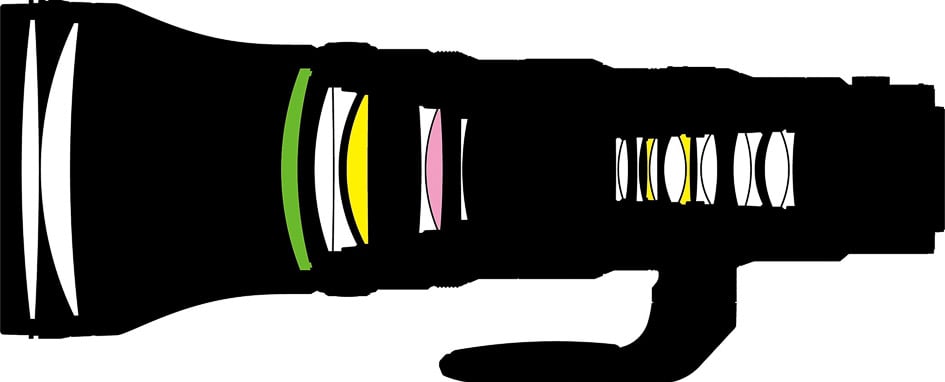
Above: Nikon Z 800mm f6.3 VR S; Below: Nikon AF-S 800mm f5.6E FL ED VR
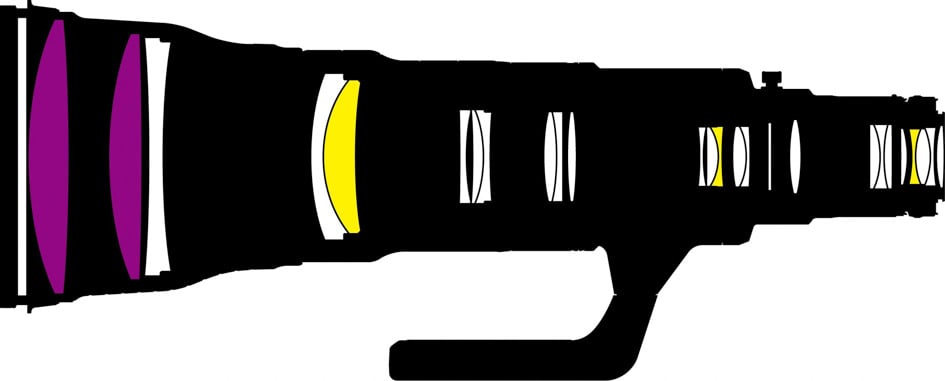
Optics: 22 elements in 14 groups including 4 special dispersion elements and one phase-fresnel lens but no aspherical element. The lens has Nikon’s Nano-coating to reduce flare, glare and ghosting plus fluorine-coating on the front element to repel water, dust, and dirt and make cleaning easier. The Z 400/2.8 + TC-2.0x combined have 26 elements in 20 groups when the built-in 1.4x TC of the lens is switched off. The F-Nikkor has 20 elements in 13 groups with two fluorite elements. The Canon RF has 26 elements in 18 groups. [+]
Closest focus distance is 4.94m (16.2ft.) with a working distance of 4.54m (14.9ft.) and a maximum magnification of 1:5.8 which is not much but similar to what the F-Nikkor offers. A magnification of 1:10 is achieved at 8.34m object distance. The Z 400/2.8 + TC-2.0x achieves a magnification of 1:2.8 at 2m working distance, the Canon RF goes down to 2.6m offering a maximum magnification of 1:2.94. [0]
Image stabilization: All three Nikkors offer optical stabilization (VR) which works in conjunction with the body-based stabilization on Nikon’s full-frame Z cameras to achieve a claimed 5.0 stops of stabilization over 5 axes for the Z 800/6.3. For the F-Nikkor the Z cameras only add roll correction to pitch and yaw correction from the lens’s VR. On a Nikon Z9 the Z 800/6.3 is the first lens where Nikon claims an additional benefit of 0.5 stops from the somewhat mysterious “Synchro-VR”. [+]
Filter-thread: The Z 800/6.3 has an integrated slot for 46mm standard filters and Nikon offers a slip-in circular polarizing filter as an additional accessory which can be easily rotated (399 EUR). It’s the same as with the Z 400/2.8. The F-Nikkor has a slot for 52mm filters. [+]
Autofocus: Yes with built-in AF stepper motor drive. Manual-focus override is by simply turning the dedicated focus ring at the middle of the lens. On Nikon Z cameras introduced October 2020 or later you can reverse focus direction. The focus ring has the usual variable gearing (like all AF Z-Nikkors so far) which allows for very precise manual focus when turned slowly and can be switched to linear response with a choice of different rotation angles – but only on a Nikon Z9 or a Z6/7 II with firmware 1.4. Focus on the F-Nikkor works differently as it has a direct linear mechanical coupling between the focus ring and the focus action. [+]
Display: No, the Nikon Z 800mm f6.3 VR S like the Z 400/2.8 does not feature an OLED display to indicate focal length, aperture, or focusing distance and depth-of-field. The F-Nikkor sports the usual distance and dof indicators on the focus ring. [0]
Additional functions: There are 4 function buttons at the front (L-Fn2) and an additional L-Fn button behind the tripod collar on the lens which can be assigned different functions like AE/AF lock like on the Z 400/2.8. There’s also a memory set button to save focus positions but the Z 800/6.3 does not offer the additional function ring of the Z 400/2.8. All three lenses also sport a focus-limiter which in case of the Z 800/6.3 prevents the lens to search focus closer than 10m (33ft.). [+]
Aperture ring: The lens has the usual slim multi-function control ring which on the Z 800/6.3 is located in front of the focus ring. The control ring can be assigned to operate the aperture (which is the default), exposure compensation, or ISO sensitivity – or simply switched off. This is the same as with the Z 400/2.8 while the F-Nikkor has no dedicated aperture ring. [+]
Lens profile: Both Z-Nikkors and the F-Nikkor come with a lens profile which can be controlled from the camera. Vignette control offers the usual options of High, Normal, Low and Off. Diffraction compensation and Auto distortion control can be activated or deactivated. [+]
All three lenses cover full frame/FX or smaller sensors. [+]
Price: 7299 EUR (incl. 19% VAT) / 6497 USD / 6299 GBP which looks like a steal when compared to the alternatives: Nikon’s AF-S 800mm f5.6E FL ED VR is 17000 EUR / 16300 USD / 19000 GBP, the Z 400mm f2.8 TC VR S is 15000 EUR / 14000 USD / 13500 GBP plus 660 EUR / 597 USD / 580 GBP for the Z TC-2.0x. Canon’s RF 800mm f5.6 L IS USM is 19949 EUR / 16999 USD / 19099 GBP. [+]
Use with teleconverters: Yes, the Z 800/6.3 can be used with the Z TC-1.4x and Z TC-2.0x, just like the Z 400/2.8 (which has a 1.4x teleconverter already built-in). Keep in mind though that the Z TCs cannot be used with the FTZ adapter. The F-Nikkor comes with the special TC800-1.25E ED included converting it into a 1000mm f7 lens. [+]
Accessories: The Z 800/6.3 comes with the same well padded case as the Z 400/2.8. It offers good protection for lens plus attached camera – a huge improvement over the usual flimsy lens-pouch most other Z-Nikkors come with. It weighs 893g and has two straps on the outside to carry a tripod plus a strap inside to secure the lens from inadvertently falling out when you open the case. It also has a grip on top and a shoulder-strap to carry it like a backpack. The lens comes with a plastic lens hood which is locked in place plus is reversible for transport. It has a rubberized front-end. Using the lens hood (either normally or in reverse) is the only way to attach the slip-on front lens cover. [+]
Tripod mount: The lens has a tripod collar ring plus foot. It has no click-stops at 90 degrees but rotates smoothly (when unlocked) and has little play. The tripod foot looks exactly the same as with the Z 400/2.8 and is firmly attached to the collar with four screws which can be removed with an Allen key. The foot weighs 121g. The whole construction feels very solid once the attachment screw is tightly locked. Under the rubber cap of the screw is a security slot for attaching an anti-theft cable. There are also two eyelets on the tripod collar to attach the included strap to. Unfortunately Nikon missed out (again) to add an Arca-Swiss compatible groove to the foot. The tripod foot has two mounting threads: one 1/4″ and one 3/8″. The latter can be used e. g. for mounting the foot directly on a half ball – which should give you the most rigid connection to a tripod. [0]
Sealing: yes. All three lenses have a rubber grommet at the lens-mount plus further special weather-sealing throughout the construction. [+]
At a score of 0[-]/3[0]/15[+] the Nikon Z 800mm f6.3 VR S turns out to be a very well featured lens – only its minimum object distance is a bit disappointing at 5m. It offers a substantially reduced weight over its predecessor which makes it a class-leader in this respect. It might have a focal ratio which is 1/3 of a stop slower than the F-Nikkor but the new lens very nicely compensates for that by being 14cm shorter and 2kg lighter plus it comes at a price which is less than half of its predecessor – or a third of Canon’s RF 800mm f5.6 L IS USM.
By the way, if you’re still concerned about size, weight, and price of 800mm lenses there are two completely different offers which are much smaller, lighter and cheaper than the lenses above – but one is only for Canon RF mount: Canon’s RF 800mm f11 IS STM sells for about 1000 EUR / 1000 USD / 860 GBP, is 102 x 282mm (in it’s retracted/collapsed state), and weighs only 1.26kg. It has optical image stabilization, autofocus and can be used with Canon’s 1.4x and 2x teleconverters. For more information have a look at Gordon’s Canon RF 600mm / 800mm f11 review where both lenses came Highly Recommended.
The other alternative is the Samyang/Walimex/Rokinon Pro 800mm f8.0 mirror lens: It’s a completely different optical design (called “catadioptric”) with two mirrors doing most of the heavy (optical) lifting just like in a classical telescope for sky-watching. At 250 EUR / 220 GBP, only 113 mm length, and barely 1kg weight it is indeed extremely cheap and small for a 800mm lens – and there are adapters for almost any camera mount. But the optical design is known to produce donut-shaped Bokeh balls, there are no electrical contacts to transmit EXIF-data to the camera, and the lens is manual focus only. This certainly precludes shooting birds in flight and makes the lens more adapt for astrophotography of bright objects like the Moon and planets. I tested two copies of this lens but was very disappointed with the results from my samples.
From left to right: Tamron 150-600mm f5-6.3 (on FTZ adapter), Nikon Z 800mm f6.3 VR S, Samyang/Walimex/Rokinon pro 800mm f8.0 (on Z adapter)
Focus
Focus accuracy and repeatability is critical to consistently produce sharp shots. Repeatability (the accuracy of focus on the same subject after repeated focus-acquisition) of the Nikon Z 800mm f6.3 VR S was measured 94.7% in Reikan FoCal – which is less than I usually get. There were no heavy outliers over a series of 40 shots on the well lit and contrasty focus test target but a quarter of the shots were more than 5% off from optimal focus. On a Nikon Z7 the lens focuses in around 0.7 sec from infinity to 8.3m (1:10 magnification), which is a little faster than the Z 400/2.8. I wasn’t able to test the Z 800/6.3 on a Z9 so maybe the lens focuses even faster on Nikon’s latest camera body. The lens showed quite some hunting even under well lit conditions especially when coming from farther away.
The focus ring is 30mm wide, has a rubberized surface, and moves smoothly. It’s a little farther to the front than on the Z 400/2.8 but still located in the middle over the tripod foot. When using the lens hand-held turn the foot out of the way if you want to use the focus ring.
AF-operation of the lens is almost silent be it in photo-mode or if you record video with the built-in microphone.
As you pull focus, you’ll notice quite some focus breathing: the image became 17% more magnified when I adjusted focus from infinity to 8.3m. This is quite visible when shooting videos.
Image stabilization
To test the effectiveness of the image stabilization with the Nikon Z 800mm f6.3 VR S on a Nikon Z7 camera body, I did a series of over 250 test-shots hand-held free-standing with shutter speeds from 1/800 of a second down to 1/25 sec. I used the shots at 1/800 sec with VR=off as reference of how good my hand-holding was at the time of the test and Reikan FoCal did the chore of evaluating the sharpness of all shots.
Without stabilization only about half of the shots at 1/800 sec were sharp (enough) – which is a clear indicator that the old 1 / focal-length rule is no longer sufficient for today’s high resolution sensors. With VR=on I could achieve slightly better results at 1/25 sec: Only 30% of the shots were too soft. This is a very impressive performance of the combined optical and sensor-based image stabilization supporting Nikon’s claim of 5 stops. Still you’d want to increase your hit rate by supporting your arms or at least your body – or use shorter shutter speeds with VR=on: At 1/50 sec and 1/100 sec results were still quite erratic but I had 80% keepers. At 1/200 sec and shorter shutter speeds variation in image quality was much reduced and the hit rate approached 100%.
I couldn’t test the benefits of “Synchro-VR” because it only works in conjunction with a Z9. Nikon said that Synchro-VR does improve stabilization by 0.5 stops. But I suspect that there is more to this new function – perhaps synchronizing sensor read-out with the movement of the VR group.
Next check out my quality results!
Check prices on the Nikon Z 800mm f6.3 S at B&H, Adorama, WEX UK or Calumet.de. Alternatively get yourself a copy of my In Camera book, an official Cameralabs T-shirt or mug, or treat me to a coffee! Thanks!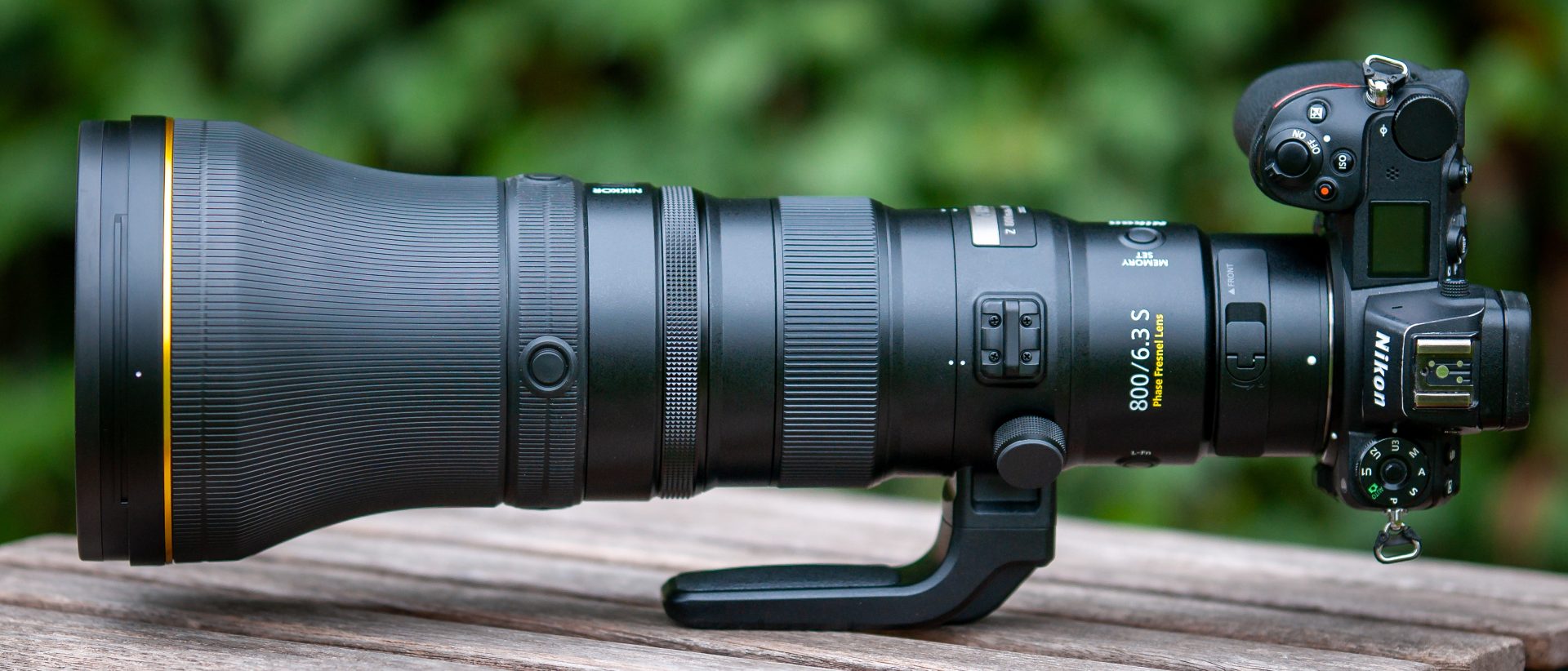
 Nikon's Z 800mm f6.3 VR S is a very good super-telephoto which is smaller and much lighter and more affordable than rival lenses for sports and wild-life photography. The lens produces very sharp images with virtually no field-curvature or colour aberrations and can confidently be used wide open. Combined with Nikon's Z TC-1.4x teleconverter it still delivers sharp images but some acuity is lost. Its Bokeh is very nice and the optical image stabilization of 5 stops proves really helpful with the challenges of hand-holding an 800mm lens. This is also helped by being only half the weight of its predecessor, the AF-S 800mm f5.6E FL ED VR. All this makes the Z 800mm f6.3 VR S a unique lens which rightfully earns a Highly Recommended.
Nikon's Z 800mm f6.3 VR S is a very good super-telephoto which is smaller and much lighter and more affordable than rival lenses for sports and wild-life photography. The lens produces very sharp images with virtually no field-curvature or colour aberrations and can confidently be used wide open. Combined with Nikon's Z TC-1.4x teleconverter it still delivers sharp images but some acuity is lost. Its Bokeh is very nice and the optical image stabilization of 5 stops proves really helpful with the challenges of hand-holding an 800mm lens. This is also helped by being only half the weight of its predecessor, the AF-S 800mm f5.6E FL ED VR. All this makes the Z 800mm f6.3 VR S a unique lens which rightfully earns a Highly Recommended.